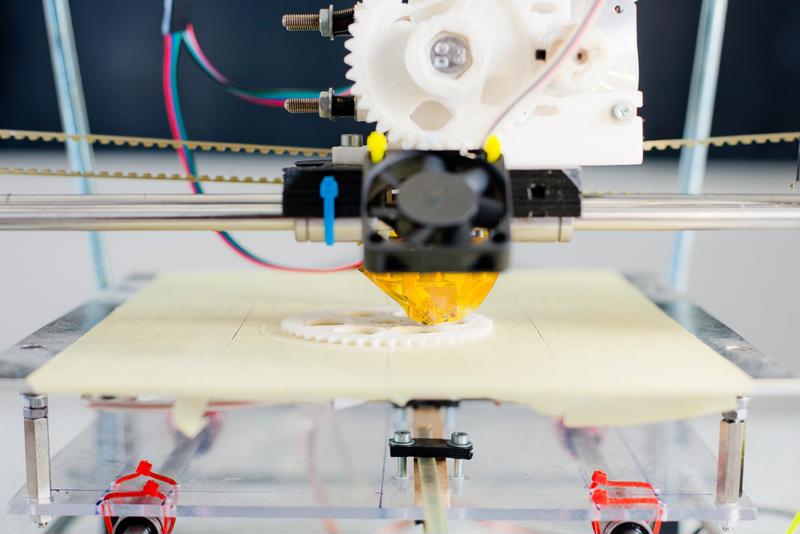
Several years ago, 3D printing technology made a big splash. Consumers were excited about the idea that they could create custom-made products in their own homes with the help of a small machine.
3D printing has come a long way since then and is being used across a wide variety of industries: from medicine to car manufacturing and from architecture to engineering. It’s now more sophisticated and has been adopted at major companies such as GE. The demand for professionals with 3D-printing skills has grown. In response, many universities have developed graduate programs centering around 3D printing and design.
Let’s take a closer look at this fascinating field and what career and academic opportunities exist within it:
What is 3D printing?
3D printing is the process of creating a three-dimensional object layer by layer, Hubs explained. The design follows a blueprint contained in a digital file and the item is built from the ground up. A range of different materials are used in 3D printing, including plastic, rubber and metal. This is different from the standard way of manufacturing products, which starts with whole raw materials and then shapes them piece by piece into a finished product. There are small-scale 3D printing machines that consumers can use in their own homes, while there are also larger, industrial-size machines that handle manufacturing for large companies.
Personal 3D printing
3D printing has been made available to consumers through machines that can be used at home. 3D printers are also being heralded for their ability to empower small business owners to create the products and materials they need without having to resort to using a big manufacturer. For example, one 3D printer company, XYZprinting, recently announced that it will release three new products this year for small businesses, schools and consumers, Forbes reported, with the goal of providing “casual users and small business owners the tools and confidence to try their hand at this technology and incorporate it into their everyday lives.”
The 3D printing industry as a whole is anticipated to be worth $32.8 billion by 2023 and demonstrate a compound annual growth rate of 25.8 percent, Business News Daily reported, citing data from a report by Markets and Markets.
Demand for professionals
As a result of the increased usability and adoption of 3D printing, there is a high demand for professionals with abilities and experience in this area. And with 3D printing being used in many industries and settings, including schools, hospitals, consumer products manufacturers, IT and aerospace, there are a wealth of career opportunities available.
According to Business News Daily, some areas that will see job growth in the next few years include 3D designers, engineers and computer-aided design experts, also known as CAD modelers. There will also be job expansion in architecture and scientific modeling roles, research and development positions, aerospace, consultants and operations support positions, such as those in finance, sales and administration.
Graduate opportunities
In response to the growing application of 3D printing and its expanding career opportunities, many universities are introducing 3D printing and related graduate programs. These programs equip students with the skills, competencies and technical abilities necessary to apply their knowledge in professional settings or to conduct academic and scientific research that furthers innovation in the field.
For example, Penn State University began offering master’s degree programs in additive manufacturing and design last year. Through the program, students learn about the “analytical and practical skills required to digitally design, develop, analyze, numerically model, optimize, fabricate and inspect new components and subassemblies using additive-manufacturing technologies.”
Northeastern University operates a Nanotechnology through Innovation in Materials Engineering – ANIMatE – initiative that combines nanomanufacturing and materials design science with 3D printing and mechatronics.
The University of Maryland also offers graduate programs in additive manufacturing, with programs including courses such as Manufacturing with Polymers, Engineering Design Methods and Applied Machine Learning for Engineering and Design.
This is just a sample of the growing number of graduate programs in 3D printing available to students. Many of these programs are also offered online, which provides advanced flexibility and convenience for students.
Having a career in 3D printing
If you’re interested in having a career in this exciting field, focus on improving your skills with computer-aided design as well as your knowledge of the mechanical operation of 3D printers and their engineering and manufacturing applications. As IT-Ology noted, there are few professional certifications and accreditations currently available for those interested in 3D printing, and as such graduate programs are the best way to strengthen your skills and begin building your career in the field.
Embrace the opportunity to cultivate a career in a new and quickly-changing field that is transforming science, business and manufacturing. Explore degree programs related to 3D printing today.

3690 East Avenue, Rochester, NY, 14618
As an independent institution in the Catholic tradition of American higher education, St. John Fishe....

10601 Calle Lee, Los Alamitos, CA, 90720
Touro University Worldwide is a nonprofit institution of higher learning established by philanthropi....

5701 Delhi Road, Cincinnati, OH, 45233
Mount St. Joseph University is a Catholic academic community grounded in the spiritual values and vi....

401 N Fairview St, Lock Haven, PA, 17745
Founded in 1870, Lock Haven University sits on the West Branch of the Susquehanna River and looks ov....

Graduate Admissions Office, Springfield, MA, 01119
Western New England University offers a diverse range of master's, doctoral, and dual degree pr....

126 Hofstra University, Hempstead, NY, 11549
At Hofstra University, students take advantage of dynamic courses, flexible schedules, exceptional f....

1000 Regent University Drive, Virginia Beach, VA, 23464
Regent University is a Christian learning community comprised of seven graduate schools (Business &a....

Doheny Campus, Los Angeles, CA, 90007
The Master of Art in Humanities at Mount Saint Mary’s University is a dynamic and fl....